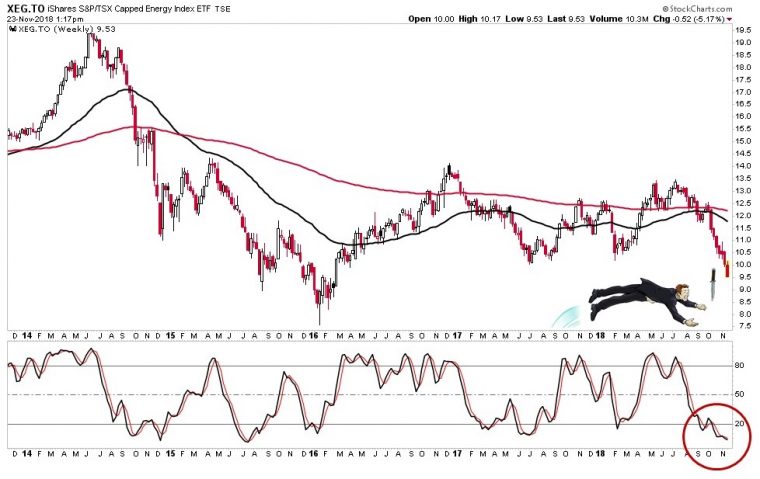Navigating a Slippery Slope

As I begin to write, oil has suffered a precipitous top to bottom (bottom? maybe) decline of over 30% from the high this year.
What drove it higher?
The most common answer has been the possibility of U.S. sanctions on Iran. This caused significant concern of a shortage in supply. A market fearful of an oil shortage bought up the futures contracts and welcomed an increase in production from Saudi Arabia and Russia. With analysts being concerned whether the increase in production would be enough, oil prices continued to move higher.
What sparked the sell off?
Resistance to the higher prices began to develop as the U.S. Dollar strengthened. Typically, a strong U.S. Dollar pushes commodities lower. Also, weighing heavy was the developing U.S.-China trade war which bolstered concerns around growth and subsequent demand for oil.
And then comes Trump! After fear of a supply disruption pushed oil higher, motivating the Russian’s and Saudi’s to increase production, Trump backed off on the sanctions, allowing business as usual for several of Iran’s key importers.
The result was a 180 from “are they pumping enough?” to “it looks like they are overproducing.” While Iran’s exports were down, they dropped nowhere near expected.
With an oversupply of oil, a higher dollar and the risk of a trade war, prices had nowhere to go but down. It should also be mentioned that the unwinding of positions by hedge funds who had previously enjoyed the run higher added significantly to the downside volatility. As the old saying goes…selling begets selling
Is there a reversal coming?
OPEC meets on December 6th and many believe that given the oversupply, they are likely to cut production. However, Trump is clearly a big fan of the lower prices tweeting “Oil prices getting lower. Great! Like a big Tax Cut for America and the World. Enjoy! $54, was just $82. Thank you to Saudi Arabia, but let’s go lower!”
With OPEC members wishing to restore balance in the market by cutting and Trump cheerleading the price of oil lower, you have significant uncertainty around just where oil is going.
To add to the uncertainty, I would pose the question as to whether Trumps lack of recognition (let alone action) against the Saudi’s direct involvement in Khashoggi ‘s assassination despite the CIA’s investigation is an attempt to perhaps influence the decision.
It seems evident that whichever the direction, it is likely to be decided on December 6th.
All this considered, Canada does have its unique challenges given the spread differential between West Texas Intermediate and Western Canadian Select. The Trans Mountain Pipeline delay impeding transportation as well as the challenge for companies pulling from oils sands to just cut production will remain a headwind. However, when the tide comes in, all ships rise and a jump in WTI should drag WCS along behind.
So, what’s the opportunity?
Crude oil is oversold technically. While there is the possibility for a continuation lower, any indication of a cut is likely to result in a significant and volatile retracement higher off the current lows. This presents an interesting trade in both crude itself and in several oil companies perhaps considered “cheap” because of where oil is trading currently. Companies which may become more “attractive” should the price of oil recover.
This is where the option market comes in handy. I had mentioned that there was some risk that oil could go lower, but should we see any indication of a production cut, the opportunity for a bounce and significant retracement higher from the inevitable “short squeeze” as well as side line investors getting back in is very attractive.
Keeping it simple, buying a call option will allow an investor to “take a shot” at the upside with a limited and identifiable risk exposure should prices continue to fall.
Before we talk option strategy, we should identify which options eligible underlying security we want to participate with.
Let’s look at 4 Canadian considerations:
- Options on HOU – BetaPro Crude Oil 2x Daily Bull ETF
- Options on ZEO – BMO Equal Weight Oil & Gas Index ETF
- Options on XEG – iShares S&P/TSX Capped Energy Index ETF
- Options on an individual company with in the sector
For this example, let’s use XEG as the underlying. The weekly chart shows our momentum indicator (stochastic oscillator) over sold, however the price action appears to still be in a free fall. This brings to mind the old saying “never try to catch a falling knife”. However, by using a call option rather than buying shares of the ETF, you create a position with a limited and identifiable risk, while having the potential of benefiting from an unlimited upside.
 Source: Courtesy of StockCharts.com
Source: Courtesy of StockCharts.com
Strike price Selection
If our expectation is that any move in our favour is likely to be significant, an “At-the-Money” to slightly “Out-of-the-Money” strike price would offer a good balance between having a reasonably high probability of being “In-the-Money” on expiration. Based on having an average Delta of 0.50, we can “assume” a 50% probability.
Expiration Date
Although we may think the move in our anticipated direction will be driven by the OPEC decision December 6th, we want to allow for a potential delayed reaction and a follow through beyond a few weeks.
With this in mind, we could select a call option expiring in February 2019. The position could be closed out at any time before expiration to lock in profits but provides additional time beyond the event to capture a potential short term trend or weather a delayed market reaction.
The Contract Specifications
Based on the above considerations, let’s look at the following trade:
- Underlying Share Price: $9.50
- Buy to Open: XEG February Call, $10.00 Strike
- Ask Price: $0.54
- Break even on expiration: $10.54
- Max risk: $0.54 per share (the price paid for the contract)
- Max profit: Unlimited
As you can see, this is one of the simpler trades to implement. Nothing fancy, just a call option as a stock (ETF) replacement strategy.
That said, the implications are significant. This simple strategy affords the investor an opportunity to “take a shot” with confidence and make an attempt to catch that falling knife all the while knowing that they can’t lose any more than the premium they’ve paid for the option contract.
CEO and Director of Business Development
R.N. Croft Financial Group
Jason is CEO and Director of Business Development at R N Croft Financial Group, a member of the Croft Investment Review Committee and a Derivative Market Specialist by designation. In addition, he is an educational consultant for Learn-To-Trade.com and an instructor for the TMX Montreal Exchange.
The information provided on this website, including financial and economic data, quotes and any analysis or interpretation thereof, is provided solely for information purposes and shall not be construed in any jurisdiction as providing any advice or recommendation with respect to the purchase or sale of any derivative instrument, underlying security or any other financial instrument or as providing legal, accounting, tax, financial or investment advice. Bourse de Montréal Inc. recommends that you consult your own advisors in accordance with your needs before making decision to take into account your particular investment objectives, financial situation and individual needs.
All references on this website to specifications, rules and obligations concerning a product are subject to the rules, policies and procedures of Bourse de Montréal Inc. and its clearinghouse, the Canadian Derivatives Clearing Corporation, which prevail over the content of this website. Although care has been taken in the preparation of the documents published on this website, Bourse de Montréal Inc. and/or its affiliates do not guarantee the accuracy or completeness of the information published on this website and reserve the right to amend or review, at any time and without prior notice, the content of these documents. Neither Bourse de Montréal Inc. nor any of its affiliates, directors, officers, employees or agents shall be liable for any damages, losses or costs incurred as a result of any errors or omissions on this website or of the use of or reliance upon any information appearing on this website.
BAX®, CADC®, CGB®, CGF®, CGZ®, LGB®, MX®, OBX®, OGB®, OIS-MX®, ONX®, SCF®, SXA®, SXB®, SXF®, SXH®, SXM®, SXO®, SXY®, and USX® are registered trademarks of the Bourse. OBW™, OBY™, OBZ™, SXK™, SXJ™, SXU™, SXV™, Montréal Exchange and the Montréal Exchange logo are trademarks of the Bourse. All other trademarks used are the property of their respective owners.
© 2024 Bourse de Montréal Inc. All Rights Reserved.
